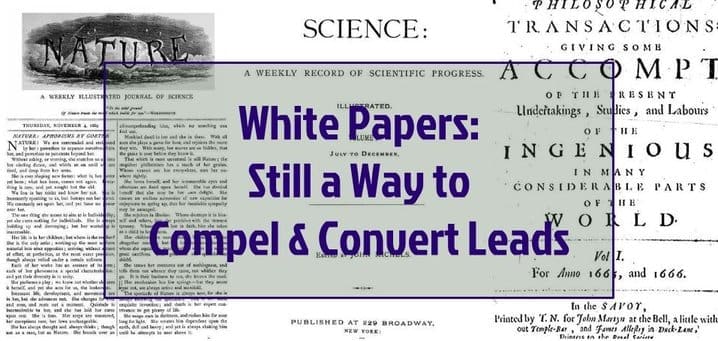For our follow-up to last week’s Expert Round Up about the utility of white papers in content marketing, we’re pleased to present friend of the blog, Tim Walker, with the “How To.”
Tim is an expert content marketer, author, speaker, and all-around Renaissance man. He has been learning the business of technology since he joined the editorial department at Hoover’s in 2000.
Besides his work as an analyst and journalist, he has nearly a decade of experience as a B2B marketer. Since 2013, he has run his own business offering editorial strategy, content marketing, and high-end writing services to both startups and larger technology firms.
Take it away, Tim!
We say “white paper” as though we all agree what it means. With that in mind, I hope that most of us aren’t spending time writing dry research reports and aiming them at a general audience.
In my experience, old-school technical white papers are useful in marketing, but only in narrow cases. Specifically, you want to use them when you know for certain that key influencers for your sale are people like network engineers, physicians, or data scientists who take pride in their technical chops.
Those specialists (occasionally including CIOs and other purchasing executives who climbed the ladder on the technical side) really do want to know that your experts can speak their language. For them, numbers and charts and footnotes digging into “speeds and feeds” or other technical, quantitative measures are like candy. [Ed. note: Like Candy. You’re welcome.]
For everybody else, the longer documents we write should be things that our buyers and influencers will want to read — and maybe even join our e-mail lists to obtain — that help them solve problems at work. Mind you that these are typically framed in operational or financial terms, not technical ones.
So, instead of trying to beat them over the head with “Here’s why our hardware runs 9% faster than the competition” {yawn}, think in terms of answering hard business questions that keep them up at night. I’m talking about things like:
- How can we manage our vendors more efficiently?
- How can we increase customer loyalty?
- Why does lead generation have to be so expensive?
It could even be a technical problem such as “How do I keep my mobile workforce secure online?” — but addressed from a conceptual, operational angle. Not positioned as a “here’s-what-our-widget-does” technical angle.
Ideally, you will get people to glance at the title of your document, realize you’re attacking that kind of problem, sit up straight, and say, “Holy moly, if they can do THAT, I’ve got to read this.” And once they’ve read it, you want them saying, “We definitely need to talk to them.”
For those audiences, steer away from “white papers” and think in terms of:
- ebooks
- research guides
- primers
- starter kits
- expert roundups
- [your approachable term here]
This is more than just semantics. If you call something a “starter kit,” YOU are much more likely to steer away from technical prose and toward material that’s visually interesting, scannable, engagingly written, and highly practical. Perhaps something that actually helps the reader get started in an area where your company has useful things to say.
Publishing that kind of document is a great way to establish your company’s chops for that reader, who may subsequently become the influencer you need to close the sale. That’s how “We definitely need to talk to them” turns into “I’m finding out what it takes to get started with them,” and then “The Big Boss is bringing them in here to show everyone what they can do for us.”
The higher your selling price or lifetime customer value, the more complex your product, or the longer your sales cycle, the more important this becomes. By writing a document that earns their attention and helps them address a real business need, you’re starting the process of education and discussion that’s required if you’re ever going to get them to smile as they sign that big purchase order.
And that, friends, is why we love Tim.
Highlight Reel: White Papers That Work
What we call things matters
Sticks and stones aside, how we name things can change the way prospects and customers look at the those document, as well as the way we treat them. Like Tim says, calling them something “lighter” changes the way we create them as content marketers AND the way site visitors consume them (or not) as prospective buyers.
That said, always remember it’s THEIR perspective that counts
It’s not about what keeps Iup at night. It should focus on what keeps them tossing and turning?
What are their pain points? What are they trying puzzle out? What thicket are they trying to hack through? How can you wayfind for them?
“Join Our Email List”
An easy- and fun-to-read guide that people want to read and for which they will happily exchange their email address. The email capture as a gated call-to-action (CTA) that expands your database, adds leads to your funnel, and recipients to your email newsletter. Sha-bam!
Featured Image Credit: compilation of three Public Domain images, left to right, First title page of the scientific journal Nature, November 4, 1869; Vol. 1 Science July-December 1880 (old series); and cover of the first volume of Philosophical Transactions of the Royal Society, 1665-1666.
Suzanne Hoenig
Latest posts by Suzanne Hoenig (see all)
- The Anti-Social-Media-Marketing Manifesto 2016 - October 19, 2016
- Which 3 Social Media Platforms Will Be Around in 3 Years? - October 13, 2016
- White Papers: Still a Way to Compel and Convert Leads - September 14, 2016





